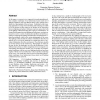Free Online Productivity Tools
i2Speak
i2Symbol
i2OCR
iTex2Img
iWeb2Print
iWeb2Shot
i2Type
iPdf2Split
iPdf2Merge
i2Bopomofo
i2Arabic
i2Style
i2Image
i2PDF
iLatex2Rtf
Sci2ools
SIGGRAPH
1998
ACM
1998
ACM
Recovering Photometric Properties of Architectural Scenes from Photographs
In this paper, we present a new approach to producing photorealistic computer renderings of real architectural scenes under novel lighting conditions, such as at different times of day, starting from a small set of photographs of the real scene. Traditional texture mapping approaches to image-based modeling and rendering are unable to do this because texture maps are the product of the interaction between lighting and surface reflectance and one cannot deal with novel lighting without dissecting their respective contributions. To obtain this decomposition into lighting and reflectance, our basic approach is to solve a series of optimization problems to find the parameters of appropriate lighting and reflectance models that best explain the measured values in the various photographs of the scene. The lighting models include the radiance distributions from the sun and the sky, as well as the landscape to consider the effect of secondary illumination from the environment. The reflec...
Related Content
| Added | 05 Aug 2010 |
| Updated | 05 Aug 2010 |
| Type | Conference |
| Year | 1998 |
| Where | SIGGRAPH |
| Authors | Yizhou Yu, Jitendra Malik |
Comments (0)

